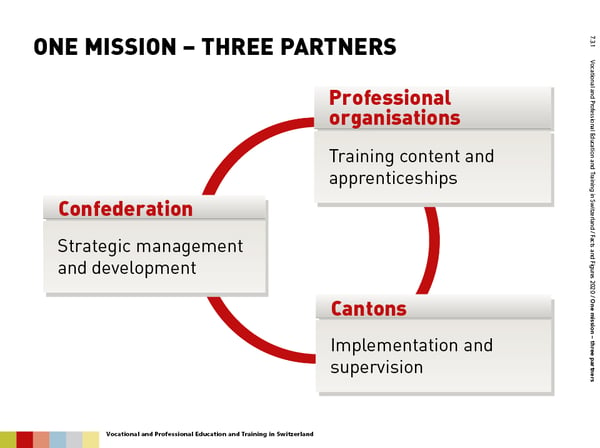Switzerland may be small in size, but it is home to one of the world’s most competitive and innovative economies in the world, ranking second in Europe and fifth in the world according to the World Economic Forum’s 2019 Global Competitiveness Report. It’s also the kind of place where an apprentice can one day become a President of the Swiss Confederation, a CEO of the largest Swiss banking institution in the world or a Director of one of the country’s biggest open-air music festivals.
A widely cited key driver and critical component to Switzerland’s economic success is its world-leading vocational education and training (VET) system. Firmly engrained in the Swiss culture and economic engine, this combined theory and practice-based model is the most popular form of upper secondary education in Switzerland. With two thirds of young people opting for foundational vocational training after coming out of compulsory education, Swiss VET caters for all kinds of students, including high achievers, who can choose from 250 different occupations. Preparing them for the world of work and supporting them throughout their careers, this system is also thought to be one of the main reasons behind the country’s comparatively low youth unemployment rates.
But what is the Swiss VET model, and what makes it so successful?
INVEST IN EDUCATION TOOLKIT
With this 10-step process, you will have all the tools you need
to master the critical areas of a successful school.
A world-class system
The Swiss federally recognized vocational education and training model is a dual-education – or dual track VET – system which combines part-time classroom instructions (usually one to two days a week) with part-time paid workplace training or apprenticeship at a host company (usually three to four days a week). The vocational training courses last two to four years and forms the basis for lifelong learning.
This model came into force in 1933, and takes it roots from the guild system, where education and training was provided by businesses specialized in craftsmanship. It may come as no surprise to learn that the first vocational school to combine theory and practice was the Watchmaking School in Geneva in 1924. Since then, professional organizations, the federal government (Confederation) and Cantons (local governments) have worked in partnership towards one mission – to ensure a high standard of quality VET and availability of an adequate number of apprenticeship positions and training courses.
Today, Switzerland is a global leader when it comes to vocational training, on-the-job training and employability and its VET model is considered a “gold standard” in comparison to other vocational education and training systems. Within the country itself, public opinion holds the vocational learning system in equal esteem to academic institutions. After all, many Swiss decisions-makers and industry leaders started off as apprentices, proving that it can drive to future career success. The VET programs also importantly cover all sectors of the Swiss economy and are focused on developing competences and delivering professional qualifications that are actually in demand, as well as occupations for which there are existing job vacancies. A wide and cross-sector talent pool of highly educated and specialist professionals are consequently at the disposal of Swiss businesses.
The Swiss model also offers a high degree of flexibility and countless learning and career growth opportunities to allow individuals to pursue further education and trainings or switch pathways between academic and vocational studies or from VET to higher education and advanced qualifications. This is one of the model’s greatest strengths, as it ensures there are no dead ends.
But for us, the recipe to the Swiss VET model’s success lies in its pedagogical method, which is characterized by a blend of skills training, strong learning outcomes and a competence-orientated structure of training content to develop both theoretical know-how and practical skills.
The top benefits of vocational learning
- Gain practical experience. Learning is hands-on, contextualized and applied in the workplace, making the academic or theoretical concepts real.
- Specialized training. Practical and technical skills are developed in line with specific industry needs, increasing employability.
- More career opportunities. Closer relationships are made with the industry or sector of interest, increasing job prospects.
- Ready-to-employ workforce. Seamless transition from apprenticeship to full-time employment.
- Accessible and affordable. Cheaper and flexible, vocational education is a good alternative to traditional university programs.
- Lifelong learning. Whether entering the workforce or retraining, employees can continuously develop their skill sets and acquire specialized training and knowledge at any point in their career.
In conclusion, vocational education is an attractive learning solution which helps produce new highly skilled, ready-to-work professionals – irrespective of whether they are young graduates or fully-fledged professionals that have sought to improve their current skills or retrain in a new field.
A ready-made solution, signed by EHL
As the world’s leading provider of hospitality education, the EHL Group has taken inspiration from the world’s best education model to create its own turnkey vocational education and training solution for the hospitality industry – VET by EHL.
This offering enables organizations and learning centers around the world to deliver quickly and efficiently ready-made Swiss hospitality training programs and administer EHL-approved professional diplomas. Using innovative methods, the program offers scalable and affordable learning solutions to potential youngsters interested in working in the hospitality industry as well as supports professionals who have opted for a career change. The objective is to ensure that the industry, which has been hit hard by the global public health crisis, is equipped with high quality trained and employable graduates and contribute to long-term employment growth in a service sector and workforce adapting to the ‘new normal’.
How EHL has adopted and adapted the Swiss VET system:
| We have “EHL-ized” the Federal VET system | SWISS FEDERAL VET | VET BY EHL |
| Learning Foundation | Learning Catalog-based | We extracted a Competency Framework to enable knowledge, skill and mindset-based learning |
| Duration | 36 months | 18 months |
| Flexibility | Possibility to shorten to 30 months for high performers | Completely modular in three 6-months modules |
| Delivery model | Dual track model – Students spend 3 years in host company and visit a public technical school | Multiple delivery models |
| Learning mode | Traditional paper-based and application-based classroom learning | Blended model – Application and team-based experiential learning |
| Learner Profile | Students with or without Baccalaureate | Students with or without Baccalaureate and Professionals (upskilling and career switching) |
| Trainer Profile | Mixed | Industry professionals |
| Trainer Methodology training | Not mandatory | EHL signature Train-The-Trainer model |




